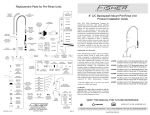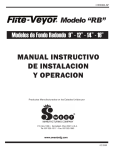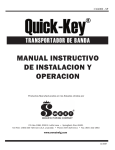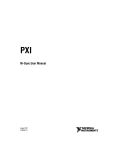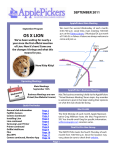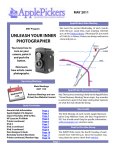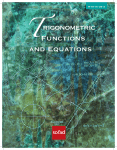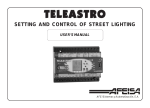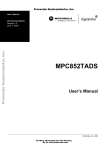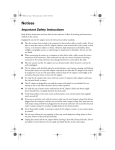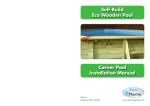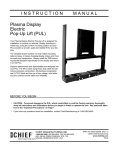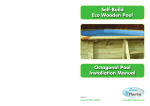Download Flite-Veyor® FB Drag 12 Series Conveyors
Transcript
I 712000 HORIZONTAL FLAT BOTTOM DRAG CONVEYORS MODEL 1012 INSTALLATION & OPERATING INSTRUCTION MANUAL Manufactured in the U.S.A. by P.O. Box 1086, 2000 E. Leffel Lane • Springfield, Ohio 45501 Toll Free: 1-800-334-7254 (in U.S.A. & Canada) • Phone: 937-325-1511 • Fax: 937-322-1963 www.sweetmfg.com 10/2013 STANDARD CONDITIONS - TERMS OF SALE Orders are subject to the approval of Sweet Manufacturing Company in writing at Springfield, Ohio, U.S.A., or by shipment of goods. All orders are considered firm contracts. Shipping dates are only our estimate based upon time required for production, and we shall not be liable for any claims for delays beyond our control, nor shall we accept cancellations or suspensions unless agreed upon, at the same time protecting us against loss caused by such cancellation or suspension. The title and right to possession of the goods covered by order shall remain with Sweet Manufacturing Company until complete and final payment therefore shall have been paid to Sweet Manufacturing Company in cash, including any interest or other auxiliary charges provided for. All goods covered by order will be considered as personal property until completely paid for, regardless of mechanical attachment to real estate. No material shall be returned without our authorization. Where written consent of Sweet Manufacturing Company is given for the return of unused goods, the purchaser will pay a minimum handling charge of fifteen percent (15%) of the original purchase price of the goods returned. WARRANTY - All items manufactured by Sweet Manufacturing Company are warranted against defects in material or workmanship for one (1) year from the date of shipment (but not against damage caused by accident, abuse, or faulty installation). Sweet Manufacturing Company will replace free of charge (F.O.B. point of supply) all such defective parts if returned to the factory, charges prepaid. All items manufactured by others and resold by Sweet Manufacturing Company are warranted to the full extent of the warranties furnished by such original manufacturer. No allowances will be made for repairs, alterations or changes unless specifically authorized by us. There are no other warranties, expressed or implied, other than title, freedom from liens, and against patent infringement. SELLER MAKES NO WARRANTY OF MERCHANTABILITY OR FITNESS FOR A PARTICULAR PURPOSE. LIMITATION OF LIABILITY - Liability of Sweet Manufacturing Company to the purchaser for damages arising out of the manufacture, sale, delivery, use or resale of the equipment, whether based on warranty, contracts, negligence, or otherwise, shall be limited to and shall not exceed the cost of the repair or replacement of defective part or parts. Upon expiration of the warranty, all such liabilities shall terminate. Sweet Manufacturing Company shall not be liable to the purchaser or user for loss of anticipated profits, loss by reason of plant shutdown, non-operation, increased expenses of operation of other equipment, or other consequential loss or damage of any nature arising from any cause whatsoever by reason of the manufacture, sale, delivery, use, or resale of the equipment covered by this order or contract. A minimum charge of Fifty Dollars ($50.00) net, exclusive of transporation charges, will be made on all orders, unless otherwise noted on invoice for the value of such material as less than this amount. All prices are F.O.B. Springfield, Ohio, U.S.A., unless otherwise agreed. Additional charges may be made for special handling, extra packing, or unusual services. Open account terms will be extended subject to approval of our Credit Department. Any federal or state taxes, sales, use, or other taxes will be added to invoice when and if assessed. All prices are subject to change without notice. Sweet Manufacturing Company P. O Box 1086 2000 E. Leffel Lane Springfield, OH 45501 Toll Free: 800-334-7254 (U.S.A. & Canada) Phone: 937-325-1511 Fax: 937-322-1963 E-mail: [email protected] HORIZONTAL TABLE OF CONTENTS INTRODUCTION ...................................................................................................................................... 1 CHECK & INSPECT YOUR ORDER ......................................................................................................... 1 TYPICAL INSTALLATIONS ....................................................................................................................... 2 SELECTING THE PROPER CONVEYOR ................................................................................................... 3 MODEL DIMENSIONS & CAPACITY......................................................................................................... 4 GENERAL - INSTALLATION & ASSEMBLY OF STANDARD CONVEYORS................................................. 5 OPTIONAL INTERMEDIATE DISCHARGE ................................................................................................ 6 INSTALLATION OF CHAIN......................................................................................................................... 6 CHAIN HANDLING ................................................................................................................................... 8 INLET / BYPASS INLET ........................................................................................................................... 8 DUMP HOPPER ....................................................................................................................................... 9 DRIVE ASSEMBLY - "V-BELT".................................................................................................................. 9 DRIVE ASSEMBLY - "GEARMOTOR" ...................................................................................................... 11 ELECTRICAL EQUIPMENT ..................................................................................................................... 12 TROUGH ASSEMBLY .............................................................................................................................. 12 INLET ASSEMBLIES ............................................................................................................................... 12 MAINTENANCE........................................................................................................................................ 14 SAFETY ................................................................................................................................................... 15 TROUBLESHOOTING .............................................................................................................................. 16 Purchase Date _____________________ Model _____________________ Serial Number___________________________________________________ INTRODUCTION The purpose of this Owner’s Manual is to advise and instruct owners of the Flite-Veyor® Horizontal Flat Bottom Drag Conveyors (hereafter referred to as Horizontal Flite-Veyor®) and accessories in the recommended installation, operation, and maintenance of the equipment. The instructions and drawings provide a step-by-step method of installation procedures. Even though installation procedures may vary because of different applications, it is suggested that if there are any questions, you refer to the instructions in this manual. To ensure long life and trouble-free operation, it is recommended that you perform regular maintenance as discussed in this manual. IT IS THE INSTALLER’S RESPONSIBILITY TO BE AWARE OF ALL FEDERAL, STATE AND LOCAL SAFETY AND ELECTRICAL CODES DURING THE INSTALLATION AND USE OF THE HORIZONTAL FLITE-VEYOR®. CHECK & INSPECT YOUR ORDER Each order or shipment is double checked before leaving the factory. All parts, pieces and components are listed item by item on our packing list, which accompanies each order. The number and description of each item, package, container, skid, etc. are listed on the bill of lading. IN SIGNING THE BILL OF LADING, THE CARRIER ASSUMES FULL RESPONSIBILITY FOR SAFE DELIVERY OF ALL GOODS TO DESTINATION IN THE SAME ORDER AS CARRIER WAS TENDERED BY THE SHIPPER. In the event of damage or shortage, have the transportation company note the same on the freight bill. You should then file a claim against the carrier for such loss and/or damage. You will find a packing list attached to one of the items in the shipment. Check each item against the list. Check by description, specification, quantity, count, etc. Should there be any discrepancies, notify us immediately. If an order or shipment includes more than one Horizontal Flite-Veyor®, the parts for each conveyor will be keyed or marked on the packing list for easy identification. Small parts and items such as bolts, washers, bushings and keys are just as important to an installation as the other components. Make sure these are located and checked before disposing of any containers or packing. We cannot be responsible for loss of items that are listed and included on our packing list. Should there be some delay between the time an order is received and the ensuing installation, store parts in a protected area so they may be easily located and identified. RETAIN PACKING LISTS FOR THIS REASON, AS WELL AS FOR FUTURE PARTS REFERENCE. 1 TYPICAL INSTALLATIONS The typical uses are shown in Figure A. Conveying materials across the top of bins from a bucket elevator. By using this method, the overall height requirement for the bucket elevator may be reduced. Separate dropouts can be used for each of the bins. Material should be allowed to drop out at the end to avoid accumulation causing the conveyor to plug when using intermediate dropouts (discharges). Unloading of bins. Use of multiple openings in the bin floor rather than a single center dropout will reduce the amount of material left in the bin as it is emptied. CAUTION! Always unload bin from the center dropout first to prevent structural failure of the bin. With drive-over pit. Material is unloaded into the hopper mounted directly on the Horizontal Flite-Veyor®. Sweet manufactures dump hoppers for use in these applications. Figure A: Typical Installations BIN LOADING DUMP HOPPER DRIVE-OVER PIT BIN UNLOADING 21 SELECTING THE PROPER CONVEYOR The following items should be noted to properly select the conveyor: 1) type and volume of material to be conveyed, usually in bushels per hour; 2) the slope of the conveyor (horizontal to 7-8 degrees standard); and 3) the number and location of dropouts and type of inlets. The Horizontal Flite-Veyor® may feed the boot of a bucket elevator by any of three different configurations: Figure B The head drive of the Horizontal Flite-Veyor® is butted up against either the up or down trunking of the elevator. In this case, a discharge transition may be used to match the boot inlet hopper. Figure C The boot is placed perpendicular to the Horizontal Flite-Veyor®. The hopper height required will depend upon the model of the elevator and whether the boot is being fed on the downside or the upside. Figure D Using the Horizontal Flite-Veyor® end discharge transition. The discharge does not require a hopper on the boot and may reduce the height to the top of the conveyor, reducing the depth of the pit required for the elevator. Figure B 3 Figure C Figure D MODEL DIMENSIONS & CAPACITY Use Figure E for capacities and dimensions. Figure E TROUGH SECTION HEAD LENGTH IN FEET Note: Dimensions (to the nearest 1/8 inch) are for reference only and may be subject to change. 10 20 30 40 50 60 70 80 90 100 110 120 130 140 150 BUSHELS PER HOUR CAPACITY AND CORRESPONDING HORSEPOWER 1000 1250 1500 1750 2000 2250 2500 2750 3000 3250 3500 3750 4000 (44 FPM) (55 FPM) (66 FPM) (77 FPM) (87 FPM) (98 FPM) (109 FPM) (120 FPM) (131 FPM) (142 FPM) (153 FPM) (164 FPM) (175 FPM) 1.0 1.0 1.0 1.0 1.0 1.0 1.5 1.5 1.5 1.5 1.5 2.0 2.0 1.0 1.0 1.0 1.5 1.5 1.5 2.0 2.0 2.0 2.0 3.0 3.0 3.0 1.0 1.5 1.5 1.5 2.0 2.0 3.0 3.0 3.0 3.0 3.0 5.0 5.0 1.5 1.5 2.0 2.0 3.0 3.0 3.0 3.0 5.0 5.0 5.0 5.0 5.0 1.5 2.0 2.0 3.0 3.0 3.0 5.0 5.0 5.0 5.0 5.0 5.0 5.0 1.5 2.0 3.0 3.0 3.0 5.0 5.0 5.0 5.0 5.0 5.0 7.5 7.5 2.0 3.0 3.0 3.0 5.0 5.0 5.0 5.0 5.0 7.5 7.5 7.5 7.5 2.0 3.0 3.0 5.0 5.0 5.0 5.0 7.5 7.5 7.5 7.5 7.5 7.5 3.0 3.0 5.0 5.0 5.0 5.0 7.5 7.5 7.5 7.5 7.5 10.0 10.0 3.0 3.0 5.0 5.0 5.0 7.5 7.5 7.5 7.5 7.5 10.0 10.0 10.0 3.0 5.0 5.0 5.0 5.0 7.5 7.5 7.5 7.5 10.0 10.0 10.0 10.0 3.0 5.0 5.0 5.0 7.5 7.5 7.5 7.5 10.0 10.0 10.0 10.0 15.0 3.0 5.0 5.0 5.0 7.5 7.5 7.5 10.0 10.0 10.0 10.0 15.0 15.0 5.0 5.0 5.0 7.5 7.5 7.5 10.0 10.0 10.0 10.0 15.0 15.0 15.0 5.0 5.0 5.0 7.5 7.5 7.5 10.0 10.0 10.0 15.0 15.0 15.0 15.0 FPM= FEET PER MINUTE. CHART IS BASED ON 45 POUNDS PER CUBIC FEET. GAUGES & SPECIFICATIONS HEAD 10 ga. TAIL 10 ga. TROUGH 10 ga. COVERS 14 ga. CHAIN Sides with flange block ball bearings Sides with flange block ball bearings and take-up Sides and bottoms Bolted flat covers 667X, D88K AR 200 ABRASION RESISTANT LINERS: Available for trough sides and bottoms. Gauge options include 10 ga., 3/16" and 1/4" and will be quoted upon request. 4 GENERAL GENERAL Only proper installation can offer the performance intended by the manufacturer. Therefore, a good installation should be of prime concern to the customer and to the installer responsible for the same. A MANUFACTURER CANNOT BE RESPONSIBLE FOR THE INSTALLATION OF A CONVEYOR. The suggestions and information contained herein are offered solely as a convenience, for we assume no liability as to installation, either expressed or implied. Unless the location of the equipment has been predetermined by a layout drawing or print, careful consideration should be given as to the depth of pits, location of inlets, possible obstructions, etc. Plan ahead for the location of supports and bracing. 8 When the Horizontal Flite-Veyor® is used to feed a bucket elevator or another conveyor, provision must be made for proper clearances to allow for drives, discharges, valves, etc. on all equipment. Also, enough clearance should be provided to allow proper maintenance of equipment after it has been installed. Proper planning prior to installation can eliminate flow plan problems. 5 6 7 D Figure F C Supporting the conveyor on a catwalk requires bolting the unit down to the catwalk every 10 feet, as shown in Figure F. These attachment brackets are available from Sweet Manufacturing Company. B LAST A INSTALLATION & ASSEMBLY OF STANDARD CONVEYORS PROPRIETARY AND CONFIDENTIAL THE INFORMATION CONTAINED IN THIS DRAWING IS THE SOLE PROPERTY OF SWEET MANUFACTURING COMPANY. ANY REPRODUCTION IN PART OR AS A WHOLE WITHOUT THE WRITTEN PERMISSION OF SWEET MANUFACTURING COMPANY IS PROHIBITED. Lay out the unit as it is to be used, including the head and tail section. Do not lift trough lengths greater than 40’ with a maximum of 20’ between lift points. Support should be provided for at least every section, or at a maximum of every 10 feet when installed. (See Figure G for typical bottom splice connections.) 7 7 6 6 5 5 NE 4 XXXXXXX 8 8 D Apply silicone caulk to flanges prior to assembly of section. Loosely install the bolts and nuts. Use a taught line to make sure the conveyor is straight horizontally. Shim, as required, to get correct alignment. Tighten the connecting hardware, making sure that the bottom of each section is no higher than the previous section, so that it will not interfere with the chain flights as they move to convey the material. At the time, check the tightness of all the hardware in the conveyor to ensure that all are properly tightened (such as the set screws in the bearings and sprockets). Conveyor troughs are provided with roller type or angle type chain returns, as specified at the time of order. Figure G C B Care should be taken to align the heights of angle returns on adjacent sections to prevent the chain flights from catching. UNLESS DIMENS TOLERA FRACTIO ANGULA TWO PL THREE P A Holes in the trough are oversized, so adjustment can be made by loosening the nuts on the threaded cross-rods that hold the angles in place. Be sure to tighten all hardware after alignment is achieved. PROPRIETARY AND CONFIDENTIAL INTERPRE TOLERAN THE INFORMATION CONTAINED IN THIS MATERIAL DRAWING IS THE SOLE PROPERTY OF SWEET MANUFACTURING COMPANY. ANY REPRODUCTION IN PART OR AS A WHOLE MATERIAL WITHOUT THE WRITTEN PERMISSION OF SWEET MANUFACTURING COMPANY IS PROHIBITED. 8 5 7 6 5 4 W:\M INTERMEDIATE DISCHARGE OPTIONAL OPTIONAL INTERMEDIATE DISCHARGE If intermediate discharges are required, the following procedure should be used. 1) Determine the location of the center of the intermediate discharge from the tail or head section. Typical intermediate discharge gates are shown in Figures H-A and H-B. 2) Locate the discharge flight support plate in the center of the discharge and make a mark at each end of the support plate onto the trough bottom. The standard bottom can then be removed from the trough and cut so the discharge flight support can be installed where the piece was removed. If the existing holes in the trough sides cannot be used, new ones must be drilled to fit the discharge flight support plate and the top flange of the intermediate discharge. The internal cut edge of the trough bottom should be ground smooth to prevent interference with the chain flighting as it passes over the opening. 8 7 6 5 4 2 3 1 REVISIONS 3) Bolt the intermediate discharge and the discharge flight support plate to the trough. The rack and pinion side may extend to either the left or the right side of the conveyor. ECN# REV. DATE DESCRIPTION APPROVED XXXXXXX ZONE D D Figure H-B Figure H-A DISCHARGE FLIGHT SUPPORT PLATE OPTIONAL SIDE DISCHARGE RACK & PINION GATE C 5 6 C 4 B A L E AV TLR VE IN INA AH CHC FF OO N ION CTIO ET DEIRC DIR XXXXXXX B TRA DRAWN CHECKED ENG APPR. PROPRIETARY AND CONFIDENTIAL THE INFORMATION CONTAINED IN THIS DRAWING IS THE SOLE PROPERTY OF SWEET MANUFACTURING COMPANY. ANY REPRODUCTION IN PART OR AS A WHOLE WITHOUT THE WRITTEN PERMISSION OF SWEET MANUFACTURING COMPANY IS PROHIBITED. DATE NAME 06-17-13 MWS XXX XXX XXX XXX MFG APPR. XXX XXX Q.A. XXX XXX UNLESS OTHERWISE SPECIFIED USE THIRD ANGLE PROJECTION 2 3 SolidWorks MANUFACTURING CO. 2000 LEFFEL LANE 2010 SPRINGFIELD,OH TITLE: OPTIONAL SIDE DISCHARGE RACK & PINION GATE FOR: 1012 HFV MANUAL SIZE B DWG. NO. A ECN# ZONE REV. STANDARD IN-LINE DISCHARGE RACK & PINION GATE REV -- XXXXXXX Optional brush system available for intermediate discharge. Refer to installation drawing provided when this option is purchased. 8 7 6 5 4 3 THIRD ANGLE SHEET 1 OF 1 SCALE: 1:12 WEIGHT: XXX 2 1 W:\Marketing-Tech Pub Images\12 Series HFV\1012 Manual\1012 Optional Side Discharge Gate INSTALLATION OF CHAIN The chain is pre-assembled at the factory. When installing the chain, make sure the tail shaft and sprocket are positioned approximately mid-position to allow for adjustment after the chain is installed. Be careful to install it with the direction of travel, as shown in Figure I. Figure I DIRECTION OF CHAIN TRAVEL 6 INSTALLATION ASSEMBLYOF OFCHAIN CHAIN (CONTINUED) (CONTINUED) The chain should be placed in the bottom and top of the conveyor and then joined with the connecting pin, as shown in Figure J. Figure J Depending on the chain and the application, the flights should be approximately 13-1/2” apart on the 667X chains and 10-1/2” apart on the D88K chain. There will be some chain and flighting left over, which should be saved for future use. Adjust shaft and sprocket to snug the chain on sprocket. Install the trough covers and splice plates before operating. Run for two hours without material. Resnug the chain. Periodically, the chain will have to be retightened and some links removed. However, the chain should be run with some slack. DANGER Exposed conveyor and moving parts will cause severe injury or death. Lockout power before removing cover or inspection door. Make sure to add oil to gear reducer before operating, as it is shipped without oil. Follow the instructions with the reducer, making sure not to overfill. 7 CHAIN CHAIN HANDLING HANDLING Figure K Chain can become twisted if improperly handled. DO NOT turn over a length of chain by twisting one end, as shown in Figure K. This may cause a permanent twist in the chain. 6 7 5 4 2 3 REVISIONS ECN# REV. DESCRIPTION XXXXXXX ZONE INLET Field installed inlets should be located at least 19 1/2” from the center of the inlet to the tail section, as shown in Figure L. However, they can be moved toward the head section as needed. Additional inlets may be added at any point in the conveyor trough. Also, see Bypass Inlet in the Options section. Figure L 19-1/2” 19 1/2" MIN. MIN. 25-1/2” 25 1/2" 6" 5 6 7 4 XXXXXXX 8 Note: Dimensions (to the nearest 1/2 inch) are for reference only and may be subject to change. D Figure M BYPASS INLET 21-1/2” 21 1/2" LAST SAVED DATE: These inlets are of special design, similar to the pit hopper, which permits bulk material to enter the conveyor between the two chains and relieves turbulence when grain enters the conveyor, therefore reducing damage to the material being handled. (See Figure M.) Bypass inlets should be used whenever there is an unregulated head of materials above the inlet, and they are recommended for all Horizontal 6 5 Flite-Veyor® conveyors. C 17-1/2” 17 1/2" PROPRIETARY AND CONFIDENTIAL THE INFORMATION CONTAINED IN THIS DRAWING IS THE SOLE PROPERTY OF SWEET MANUFACTURING COMPANY. ANY REPRODUCTION IN PART OR AS A WHOLE WITHOUT THE WRITTEN PERMISSION OF SWEET MANUFACTURING COMPANY IS B PROHIBITED. 7 22-1/2” 22 1/2" 18" 18” 19” 19" Monday, June 17, 2013 1:21:55 PM UNLESS OTHERWISE SPECIFIED: DATE NAME DRAWN DIMENSIONS ARE IN INCHES TOLERANCES: FRACTIONAL= 1/32" CHECKED ANGULAR BEND = 1/2 ENG APPR. TWO PLACE DECIMAL = .03 THREE PLACE DECIMAL = .015 MFG APPR. 06-17-13 MWS INTERPRET GEOMETRIC TOLERANCING PER: MATERIAL USED ON NEXT ASSY SEE DRAWING MATERIAL CODE Q.A. XXX XXX XXX XXX XXX XXX XXX XXX FOR: 1012 HFV MAN SIZE THIRD ANGLE -- B DWG. NO. XXXXXXX SCALE: 1:8 3 2000 LEFFEL TITLE: INLET INSTALLA UNLESS OTHERWISE SPECIFIED USE THIRD ANGLE PROJECTION APPLICATION 4 MANUFACTURING CO. WEIGHT: XX 2 W:\Marketing-Tech Pub Images\12 Series HFV\1012 Manual\101 Note: Dimensions (to the nearest 1/2 inch) are for reference only and may be subject to change. LAST SAVED DATE: UN 8 A DI TO FR AN TW TH INT TO PROPRIETARY AND CONFIDENTIAL THE INFORMATION CONTAINED IN THIS DRAWING IS THE SOLE PROPERTY OF SWEET MANUFACTURING COMPANY. ANY REPRODUCTION IN PART OR AS A WHOLE WITHOUT THE WRITTEN PERMISSION OF Wedn MA NEXT ASSY USED ON MA DUMP HOPPER A dump hopper has been developed for use with the Horizontal Flite-Veyor®, as shown in Figure N. The grain enters 5 6 2 8 both sides of the 3 7 through openings in trough and eliminates the drag caused by the4 top chain moving in the material, greatly reducing the horsepower required for pit applications. A 120” hopper pit opening unit is fabricated in standard 10’ trough sections. To determine the additional horsepower required to drive the Horizontal Flite-Veyor® with a dump hopper, add 20’ to the length of the conveyor. For additional information, consult the Sweet Manufacturing Company D Engineering Department. REVISIONS ECN# REV. DESCRIPTION XXXXXXX ZONE 2” 2" Figure N 44" 44” 120" 120” C 2" 2” 12-1/2” 12 1/2" B 10" 10” 17 1/2" 17-1/2” Note: Dimensions (to the nearest 1/2 inch) are for reference only and may be subject to change. DRIVE DRIVE ASSEMBLY ASSEMBLY - “V-BELT” LAST SAVED DATE: Wednesday, June 19, 2013 9:52:32 AM UNLESS OTHERWISE SPECIFIED: DATE NAME DRAWN DIMENSIONS ARE IN INCHES TOLERANCES: FRACTIONAL= 1/32" CHECKED ANGULAR BEND = 1/2 ENG APPR. TWO PLACE DECIMAL = .03 THREE PLACE DECIMAL = .015 MFG APPR. 06-19-13 MWS The V-beltAdrive assembly includes a shaft-mount reducer with torque-arm and reducer bushing, motor mount, sheaves TITLE: DUMP H with bushings, V-belts and belt guard. Torque-arm mounting channel (see Figure O), which bolts to the trough justFOR: 1012 HFV behind the head section, is supplied on shaft-mounted gear boxes up to 15 HP. The standard drive is provided to mountSIZE DWG. NO. XX -on the lefthand side of the head section (when viewing from the tail section). Provisions for righthand drives can beB SCALE: 1:18 WEIG made at the factory, 6 4 8 if so ordered. 7 2 3 5 INTERPRET GEOMETRIC TOLERANCING PER: PROPRIETARY AND CONFIDENTIAL THE INFORMATION CONTAINED IN THIS DRAWING IS THE SOLE PROPERTY OF SWEET MANUFACTURING COMPANY. ANY REPRODUCTION IN PART OR AS A WHOLE WITHOUT THE WRITTEN PERMISSION OF SWEET MANUFACTURING COMPANY IS PROHIBITED. MATERIAL USED ON NEXT ASSY SEE DRAWING MATERIAL CODE Q.A. XXX XXX XXX XXX XXX XXX XXX XXX MANUFACTURING CO. UNLESS OTHERWISE SPECIFIED USE THIRD ANGLE PROJECTION THIRD ANGLE APPLICATION W:\Marketing-Tech Pub Images\12 Series HFV\1012 Manual\1012 D Proper installation of the speed reducer is essential to provide efficient, economical operation and a long life. Install the reducer as follows: 1) Make certain that the drive shaft, on which the reducer is to be mounted, is clean and free from burrs. Remove any protective coating on the drive shaft in the hollow speed reducer. Coatings may be removed by using a non-flammable solvent. 2) Inspect and locate machine key in drive shaft. CAUTION: For safe handling of the reducer, use only proper lifting equipment having ample load carrying capacity. Hand lifting is dangerous. It is good practice to avoid excessive overhang on both drive shaft and input shaft by mounting reducer as close as possible to bearing support and the V-belts as close as possible to the reducer. DO NOT force reducer when mounting on shaft, as you may damage the bearings. 3) Slide the drive assembly (reducer and motor mount) onto the head shaft. 4) When reducer has been properly positioned, secure bushings or set screws against drive shaft. Stake keyseat in drive shaft to prevent key from moving. 9 8 5 6 7 4 3 ECN# ZONE REV XXXXXXX DRIVE ASSEMBLY - “V-BELT” (CONTINUED) 5) Install the torque-arm on the torque-arm channel on the first trough section, as shown in Figure O. D CAUTION: Speed reducers are shipped without oil. Be sure to lubricate properly before operation. Refer to the nameplate and service manual for lubrication instructions. 6) Torque-arm mounting channel must be welded to bottom of the trough. Paint or cover weld strip with galvanized paint. Figure O C B TORQUE ARM MOUNTING CHANNEL 7) BEFORE INSTALLING THE V-BELTS AND SHEAVES, install the rear or back side of drive cover and mounting bracket, following the instructions in Figure P. Install proper sheaves on motor and reducer. Check packing LAST SAVED DATE: Monday, June 17, 2013 2:23:57 P list and sheave carton for markings and identification. Interchanging sheaves will result in improper chain speed and unsatisfactory conveyor operation. 8 A 5 6 7 4 2 3 UNLESS OTHERWISE SPECIFIED: 1 MOTOR D Figure P DRAWN DIMENSIONS ARE IN INCHES TOLERANCES: FRACTIONAL= 1/32" CHECKED ANGULAR BEND = 1/2 ENG APPR. TWO PLACE DECIMAL = .03 THREE PLACE DECIMAL = .015 MFG APPR. D 8 C 6 7 Q.A. INTERPRET GEOMETRIC TOLERANCING PER: PROPRIETARY AND CONFIDENTIAL THE INFORMATION CONTAINED IN THIS DRAWING IS THE SOLE PROPERTY OF SWEET MANUFACTURING COMPANY. ANY REPRODUCTION IN PART OR AS A WHOLE MOTOR WITHOUT THE WRITTEN PERMISSION OF SWEET MANUFACTURING COMPANY IS PROHIBITED. MATERIAL NEXT ASSY MOUNT USED ON SEE DRAWING MATERIAL CODE -- APPLICATION 4 5 C 3 W:\Marketing-Tech Pub Im SHEAVES REDUCER MOUNTING BRACKETS B B BUSHINGS BACKING PLATE BELT A A PLASTIC DRIVE COVER Mount sheaves as close to bearings as possible to minimize overhung loads. Align sheaves by using a straight edge placed across the outer faces of both sheaves. Be sure keys are properly installed and tighten set screw firmly. 8 7 6 5 4 3 2 UNLESS OTHERWI THIRD ANGLE PRO 1 NOTE: The head shaft speed may be improper due to installing the wrong sheaves on motor and reducer. Refer to packing list for proper placement of sheaves. 10 DRIVE DRIVE ASSEMBLY ASSEMBLY - “GEARMOTOR” The gearmotor drive assembly includes a shaft-mount reducer with mounting bracket, vibration pad and antirotation channel. (See Figure Q.) The standard drive is provided to mount on the lefthand side of the head section (when viewing from the tail section). Provisions for righthand drives can be made at the factory, if so ordered. Proper installation of the gearmotor is essential to provide efficient, economical operation and a long life. Install the reducer as follows: 1) Attach gearmotor (A) to head shaft. 2) Bolt mounting bracket (B) to gearmotor. 3) Bolt vibration pad (D) and antirotation channel (C) to mounting bracket (B) and end of head assembly. 4) Do not overtighten bolts on vibration pad. Figure Q B C D 11 A ELECTRICAL EQUIPMENT Emergency stop switches, shut-off switches, dual set point motion detectors, overload devices and other electrical controls are all necessary considerations for a safe conveyor installation. (Controls and switches are usually furnished by conveyor user.) TROUGH ASSEMBLY Horizontal Flite-Veyor® troughs are available in up to 10’ sections. The desired length and height of conveyor is achieved through a combination of sections. The trough is assembled by bolting splices together using 3/8” bolts and nuts. The bottom is joined using a bottom splice channel. To attach the bottom splice channel, remove the end bolts in the bottom of two adjacent trough assemblies and match splice channel to holes in the two trough sections. Care should be taken to align the heights of angle returns on adjacent sections to prevent the chain flights from catching. Holes in the trough are oversized, so adjustment can be made by loosening the nuts on the threaded cross-rods that hold the angles in place. Be sure to tighten all hardware after alignment is achieved. The head and tail assemblies can be attached to the trough in a similar manner. The bottom splice channel for the head is already bolted to the head assembly. INLET ASSEMBLIES DUMP HOPPER The bypass dump hopper provides a regulated flow of material onto the chain paddles. This reduces material damage, chain shock and horsepower requirements. BYPASS INLET HOPPER The bypass inlet hopper is 18” long, 17-1/2” tall and 12” wider than the basic conveyor trough. It provides a regular flow of material onto the chain and paddles. Bypass inlet hoppers are field installed, as shown in Figure R. STANDARD SQUARE FRAME INLET The standard (square frame) inlet is mounted directly on top of the conveyor trough. This should only be used where some other means of controlling the flow is above the inlet (e.g., rack and pinion valve). AR 200 STEEL TROUGH BOTTOM (OPTIONAL) Optional AR (abrasion resistant) steel bottoms are available in 10 ga., 3/16” or 1/4” thickness for the Horizontal FliteVeyors®. AR steel wears less, as it is much harder than standard steel. This option is installed before units are shipped. AR 200 SIDE LINERS (OPTIONAL) Optional AR sides are available and will be quoted on request. 12 A B C D E F 8 8 7 7 CUT OUT & REMOVE TOP FLANGE OF TROUGH ON BOTH SIDES FOR BYPASS INLET (SEE DIMENSIONS ON SIDE VIEW BELOW) 5 18" 18” 2-1/2” 2 1/2" 4 13 6 5 4 3 ECN# ZONE REV. DESCRIPTION 1 DATE BOTH SIDES 3/16" (WELDING OPTIONAL) 3 PROPRIETARY AND CONFIDENTIAL THE INFORMATION CONTAINED IN THIS DRAWING IS THE SOLE PROPERTY OF SWEET MANUFACTURING COMPANY. ANY REPRODUCTION IN PART OR AS A WHOLE WITHOUT THE WRITTEN PERMISSION OF SWEET MANUFACTURING COMPANY IS PROHIBITED. NEXT ASSY 2 APPLICATION USED ON ---- ---- ---- ---- ---- ---- THIRD ANGLE UNLESS OTHERWISE SPECIFIED USE THIRD ANGLE PROJECTION Q.A. MWS NAME ------- DATE 06-18-13 2000 E. LEFFEL LANE 2010 D 1 -- XXXXXXX WEIGHT: DWG. NO. SCALE: 1:8 SIZE FOR: 1012 HFV CONVEYOR - SHEET 1 OF 1 REV SPRINGFIELD,OH SolidWorks TITLE: BYPASS INLET INSTALLATION MANFACTURING CO W:\Marketing-Tech Pub Images\12 Series HFV\1012 Manual\1012 Bypass Inlet Installation DO NOT SCALE DRAWING -- SEE DRAWING MATERIAL CODE MATERIAL INTERPRET GEOMETRIC TOLERANCING PER: DIMENSIONS ARE IN INCHES DRAWN TOLERANCES: FRACTIONAL = 1/32" CHECKED ANGULAR BEND = 1/2 ENG APPR. TWO PLACE DECIMAL = .03 THREE PLACE DECIMAL = .015 MFG APPR. UNLESS OTHERWISE SPECIFIED: LAST SAVED DATE: Tuesday, June 18, 2013 11:20:23 AM APPROVED XXXXXXX REVISIONS REMOVE TROUGH BOTTOM BOLTS & NUTS, THEN RESECURE AFTER INSTALLATION OF BYPASS INLET. 2 AFTER CUTTING & REMOVING SECTIONS FROM BOTH SIDES, PLACE THE BYPASS INLET. LOCATE & DRILL (4) 17/32" HOLES ON EACH SIDE OF THE TROUGH FOR 3/8" CARRIAGE BOLTS (SUPPLIED BY OTHERS) OR WELD ALONG THE EDGES OF THE BYPASS INLET ON BOTH SIDES OF THE TROUGH. Note: Dimensions (to the nearest 1/8 inch) are for reference only and may be subject to change. SIDE VIEW SHOWING CUTOUT DIMENSIONS 5 1/8" 5-1/8” 21 3/4" 21-3/4” COVERS NOT SHOWN FOR CLARITY. CUT OUT & REMOVE SECTION ON BOTH TROUGH SIDES & LINERS, IF APPLICABLE, FOR BYPASS INLET (SEE DIMENSIONS ON SIDE VIEW BELOW) 6 Figure R Horizontal Flite-Veyor® Bypass Inlet Installation A B C D E F MAINTENANCE MAINTENANCE After approximatley ten (10) hours of use, retighten all set screws on the bearings for the head and tail shafts, as well as the bushings on the sprockets and reducer. Check the chain slack in the conveyor and the V-belt tension in the drive. This should be repeated after every fifty (50) hours of operation. CAUTION: CORRECT LUBRICATION DO NOT START UNIT WITHOUT FIRST FILLING REDUCER WITH OIL! SPEED REDUCER The shaft-mounted speed reducer is lubricated by an oil reservoir in the housing. The correct amount of oil is important to the proper operation of the reducer. Too much oil may cause leakage or overheating. Too little oil may cause overheating or damage to internal parts. Refer to reducer manufacturer’s specific guidelines for a list of recommended lubricants, capacities and oil change periods. WARNING!! DO NOT USE lubricants of the EP (extreme pressure) type, those containing slippery additives or heavy weight (90-140 wt.) gear lube. It is recommended that oil be drained and housing flushed after the first 150 hours of operation and that the oil be changed every 2,500 hours thereafter. Check the oil level occasionally when the unit is not operating and add as required. CAUTION!! Keep breather holes clear at all times to prevent pressure buildup in reducer. For dusty, corrosive environments, reducer manufacturer offers different breathers for more protection. If different breathers are needed, contact Sweet Manufacturing Company’s Sales Department at 800-334-7254 or [email protected] to reorder. WARNING!! NEVER remove breather plug or oil level plug while the drive is in operation, or personal injury may result! Check these only when drive is not operating. INSPECTION An inspection schedule should be established in order to ensure that the equipment is in good operating condition at all times. Regular inspections will help to reveal little things such as loose bolts, damaged paddles, etc. before they become serious and damaging problems. Here are some of the things that should be inspected and maintained regularly: 1) Inspect chain and paddles for loose bolts, damaged flights and chain condition. 2) Check chain tension. Remove necessary links if it cannot be adjusted further. 3) Inspect V-belts for tension and condition. V-belts should be replaced with a MATCHED SET OR A BANDED BELT. 4) Check speed reducers regularly for sufficient oil and signs of leakage. KEEP BREATHERS CLEAN. 5) Check bearings for sufficient lubrication and evidence of overheating. 6) Check all sheave and drive attaching parts for sufficient tightness. 7) Check all hardware and tighten as required. 8) Check all safety labels regularly. When they become illegible, contact Sweet Manufacturing Company’s Sales Department at 800-334-7254 or [email protected] to reorder. 14 SAFETY SAFETY WARNING! Make inspections when all operations are stopped and lockout and tagout procedures are completed. The importance of exercising EXTREME CARE when erecting and maintaining a Horizontal Flite-Veyor® cannot be overemphasized. Working at heights reached by even the smallest installations can be hazardous, unless safety precautions are taken. In any case, BE CAREFUL - DO NOT HURRY - AND REMEMBER WHERE YOU ARE AT ALL TIMES. Your conveyor has been designed to comply with CEMA safety standards. These safety standards can be obtained through the American Society of Mechanical Engineers as ASME B20 (1993). Operating and maintenance personnel should be thoroughly trained in safe operating procedures, recognition of possible hazards and maintenance of a safe area around the conveyor. WARNING Shown at right is an example of the warning sign attached to conveyor covers. (Refer to #8 under Inspection on Page 13 for instructions to reorder safety labels.) The following safety guidelines should be followed: AVOID SERIOUS INJURY OR DEATH. This machine must be locked out in accordance with current OSHA requirements before any maintenance or service is performed. THESE ARE GUIDELINES ONLY, AND COMPLIANCE WITH SAFETY STANDARDS - FEDERAL, STATE AND LOCAL, INCLUDING OSHA - IS THE RESPONSIBILITY OF THE USER. 1) 2) 3) 4) 5) 6) 7) 8) 9) 10) 15 Maintain a safety program for all operating personnel. All operating personnel should be advised of the location of all emergency controls and devices. Good lighting, housekeeping and maintenance contribute to a safe work area. Frequent inspections should be made of all conveyor equipment, and all safety devices should be in position and in proper working order. Conduct a pre-startup safety check of all conveyor equipment to determine that the machinery and area are safe for operation and that guards and warning devices are in place. There should be absolutely NO reckless actions or horseplay in the vicinity of conveyors. Most accidents are caused by lack of proper safety training, carelessness, horseplay or lack of awareness of possible hazards. Conveyors should not be operated unless the conveyor housing completely encloses the moving elements and power transmission guards are in place. If the conveyor cover or housing is to be opened, the motor must be locked out/tagged out electrically in such a way that it cannot be restarted by anyone in the vicinity or remotely from the conveyor. Overflow cover sections or doors should not be opened while the conveyor is operating. If, because of its application, the conveyor must have open housing, then the entire conveyor must be separated from personnel areas by a fence, and warning signs must be posted. Open feed hoppers or spouts for shovel, front end loaders or their manual or mechanical loading must incorporate a grating. If the characteristics of the material being handled are such that a grating cannot be used, then the exposed portion of the conveyor must be guarded by a fence and warning signs must be posted. DO NOT walk or stand on the conveyor cover, grating or power transmission guards. TROUBLESHOOTING Problem Cause Remedy Conveyor not running at full capacity Verify that inlet is not backed up or that the equipment feeding conveyor is not plugged. Incorrect chain speed Verify that the head shaft speed is what was ordered. If within one to two RPM of what was sold, this is not the problem. If the head shaft RPM is drastically different, the causes could be improper sheaves, V-belts slipping, improper gear reduction on reducer or an electrical problem. Correct situations as required. Improper inlet installation Verify that the standard inlet is installed as shown in this manual. Too much material being carried to the tail affects the overall HP requirements and efficiency of the conveyor. If using a standard bypass or dump hopper, verify that the material is feeding into the conveyor areas. Bent or missing flights Replace and/or straighten as needed. Conveyor plugged with product Verify that the discharge is not clogged or backing up. Conveyor may be running too fast to discharge, allowing material to return on the return side. Slow conveyor down as required to prevent plugging. Also, you may need to regulate feed into conveyor. Flights banging on bottoms Improper alignment of conveyor sections. Flights hitting trough covers Chain too tight. Chain should not be rubbing covers over entire length of conveyor. Ideally, the chain should ride just below the covers on the trough. Conveyor making squeeling noise Some noise is acceptable. The sound of the flights and bottoms makes this type of noise. However, if the noise doesn’t quiet down when running the conveyor with product, there may be other issues. Readjust tension on chain and run again. Damaged flights Replace damaged flights as required. Loose flights Tighten as required. Chain and/or sprockets worn Replace as required. Incorrect capacity Noisy conveyor 16 TROUBLESHOOTING (CONTINUED) Cause Problem Excessive UHMW flight wear Sprockets showing uneven wear Remedy Conveyor sections misaligned Align conveyor sections as required to realign sections. Sprockets not aligned and/or centered Center sprockets and realign as necessary. Check set screws on bushings to make sure the sprockets do not move from alignment. Worn chain Replace chain as required. Improper sprocket alignment Center sprockets and realign as necessary. Check set screws on bushings to make sure the sprockets do not move from alignment. CAUTION: As chain and/or sprockets wear and need replacement, the chain manufacturer recommends replacing both for longer life of the replacement parts. 17 Our Mission To provide innovative quality solutions that create an extraordinary customer experience.





















